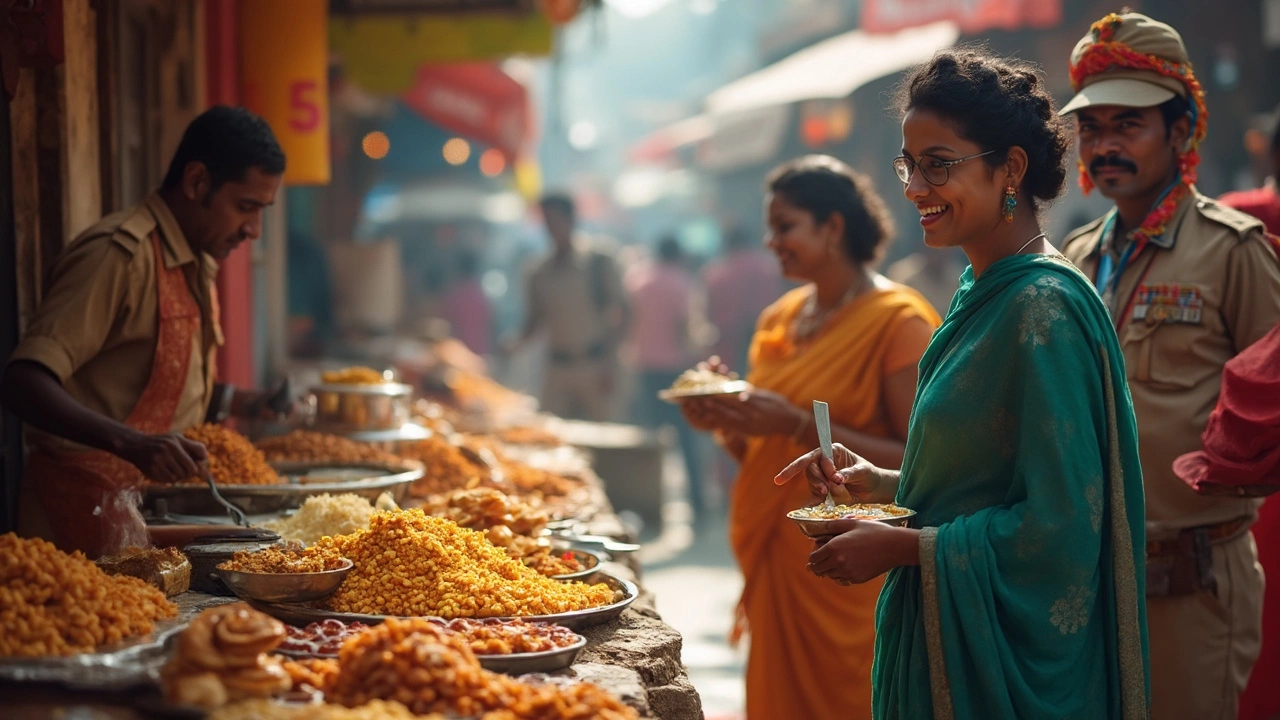Street food in India isn’t just a meal—it’s an experience. But here’s the thing most people don’t realize: selling street food isn’t fully illegal, but it definitely comes with legal twists. India’s cities aren’t all on the same page. Some have specific rules, some barely enforce them, and others tend to look the other way—unless there’s a complaint or crackdown.
If you’ve ever seen a vendor’s cart pushed away by police, you might think street food breaks the law. The reality’s more complicated. Laws like the Street Vendors (Protection of Livelihood and Regulation of Street Vending) Act, 2014 actually protect street vendors’ rights. Still, not every hawker has the right paperwork or stands in the ‘approved’ spot, making them easy targets during enforcement drives.
- The Law Versus the Reality
- Street Vendors and Permits
- Health and Safety: What’s the Deal?
- How to Eat Safely Like a Local
The Law Versus the Reality
If you ask three people whether street food is actually legal in India, you’ll probably get three different answers. Here’s what’s really going on. The Street Vendors Act of 2014 is the main law for this, and it clearly says street vendors have the right to earn a living. It doesn’t call selling street food illegal at all—instead, it protects vendors from being harassed just for setting up shop on a footpath or roadside.
But here’s where things get tangled. While the Act sounds great on paper, things play out differently on the ground. To actually sell legally, vendors need a license or a permit from local authorities. Getting this paperwork isn’t easy: in big cities like Delhi, Mumbai, and Bengaluru, the number of licenses gets capped, and the system can be slow or confusing. That’s why lots of vendors skip the process and operate without official permission.
The tricky part is enforcement. In some areas, police and municipal workers let vendors run their stalls—unless there’s a specific complaint. During big festivals or VIP visits, though, crackdowns happen where carts get confiscated and fines handed out. It’s unpredictable.
If you’re wandering the streets, you’ll notice vendors everywhere, right in front of railway stations, bus stops, and even school gates. This goes to show that the law itself isn’t stopping people from selling, but not everyone’s following the nitty-gritty rules either. It leaves a lot of gray areas—so vendors might be legal under one set of rules but breaking another at the same time.
The bottom line: selling street food is not outright illegal, but most vendors are stuck in a confusing middle zone between what the law allows and what really happens every day. If you want to try local stalls, you’re not helping anyone break the law, but it’s good to remember how tricky this balancing act is for the people serving you those tasty snacks.
Street Vendors and Permits
Getting legal as a street food vendor in India isn’t a walk in the park. There’s a clear rulebook—thanks to the Street Vendors Act, 2014—but actually following it can be tricky on the ground. The law says every street vendor should have a license or a permit, mostly handed out by the city’s local municipal body or a Town Vending Committee (TVC).
Permits are meant to make things official. But in reality, the process is slow and confusing in many cities. Sometimes the number of allowed permits is way lower than the number of people actually selling street food. In Mumbai in 2023, there were over 1.25 lakh vendors, but less than 15,000 permits got issued that year. The rest sell on the streets in a grey area—not exactly illegal, but not completely protected either.
Here's what’s usually needed to get a street vending permit:
- Proof of identity and address (like Aadhaar or ration card)
- Details about where you want to set up your cart or stall
- A fee—this changes from city to city
- Sometimes, a no-objection letter from nearby shops
The application gets reviewed, and if you’re lucky, the Town Vending Committee clears you. But many sellers skip the headache because the system is slow or out of their reach. They risk being moved by police or city officials during crackdown drives.
Here’s a quick snapshot of official numbers in a few cities:
| City | Registered Vendors (2023) | Estimated Total Vendors |
|---|---|---|
| Delhi | 41,000 | 240,000+ |
| Mumbai | 14,800 | 125,000+ |
| Kolkata | 18,500 | 100,000+ |
It helps to know that not all cities run tough checks all the time. In places like Ahmedabad or Chennai, enforcement comes and goes, often only getting serious before big events or following complaints.
If you’re eager to set up a stall, get familiar with your city’s rules. Hang on to your paperwork, pay the fee, and talk to folks who’ve done it before. If you’re just looking to eat, don’t worry—having a permit doesn’t always mean better food, but it does mean less risk of the vendor being moved off or fined mid-meal.

Health and Safety: What’s the Deal?
Eating street food can be a thrill, but it can also be a gamble, especially if you have a sensitive stomach. Indian street vendors often cook in the open, sometimes using water from sources you wouldn’t want to see. Most cities ask vendors to follow basic hygiene rules and get regular health checks, but not all of them bother or even know about it.
In 2022, a survey in Mumbai found that about 40% of stalls had no hand-washing facilities. That’s just one of the reasons people sometimes get sick after eating pani puri or chaat in crowded markets. Health authorities have carried out surprise checks, especially around festival season, and it’s not rare for them to trash batches of food or even shut down a stall if they spot unsafe practices.
The Food Safety and Standards Authority of India (FSSAI) sets guidelines for cleanliness and food safety. They also run the ‘Clean Street Food Hub’ campaign, encouraging clusters of vendors to upgrade their standards. Dr. Arun Singhal, the CEO of FSSAI, put it plainly:
“Street food is safe if vendors follow simple hygiene—fresh ingredients, clean water, and regular hand-washing make all the difference.”
But here’s the catch: enforcement is patchy. Whether you’re in Kolkata or Delhi, many favorite spots don’t display any hygiene certificates. So what can you do as a customer? Watch for a vendor who:
- Uses filtered or bottled water for cooking and drinks
- Prepares food fresh in front of you
- Wears gloves or uses tongs instead of bare hands
- Keeps raw materials and ready food covered
People love street food for its taste, but it’s smart to trust your instincts—and your eyes. If a stall looks shady, skip it for one that feels cleaner and busier. Locals usually know where the safest spots are, so following the crowd isn’t just about taste; it’s about staying healthy, too.
How to Eat Safely Like a Local
If you want to enjoy street food in India without risking a stomach ache, you’ve got to know a few things locals swear by. It’s not a complicated science, but it does need a bit of street smarts and awareness of what’s going on around you.
- Watch where the crowds go: If a stall is packed, chances are the food is both tasty and fresh. Locals won’t take risks with vendors known for bad hygiene. High turnover usually means nothing sits out too long.
- Check the setup: See how the vendor handles food. If they’re using gloves, tongs, or even just making sure they don’t touch money and food with the same hand, that’s a good sign. Water used for washing should look clean, and plates (even if disposable) shouldn’t be reused.
- Pick hot, freshly cooked stuff: Foods like vada pav, samosas, and chole bhature are safest when you see them sizzle out of the oil or pan. Cold salads, chutneys, or things cut and left in the open attract more germs, especially on hot days.
- Stick with bottled water: Don’t trust tap water for drinking or in chutneys and juices. Sealed bottled water is the safest bet. Some locals even skip drinks with ice, just to be extra cautious.
- Ask the locals: If you’re not sure, just ask someone standing in line or a shop nearby where they like to eat. Nothing beats a real recommendation.
Look at these interesting facts about food safety in India’s street food scene:
| Fact | Detail |
|---|---|
| Registered Street Vendors (2023) | About 5.6 million across major cities |
| Incidents of Reported Foodborne Illness Linked to Street Food | Estimated 13,000 annually in urban centers |
| FSSAI Inspection Drives (2022-24) | 3 out of 10 vendors in city centers passed the first surprise check |
| Cities with Active Vendor Licensing Systems | Less than 50% as of 2024 |
One last thing—trust your gut. If something smells weird or looks off, skip it. There’s always another stall just around the corner serving something delicious and safe. If you ever get a mild tummy trouble, many locals rely on over-the-counter rehydration sachets (ORS) and stick to simple foods for a day. But honestly, if you follow these tips, you’ll probably do just fine—just like the locals who’ve made Indian street food an everyday adventure.
